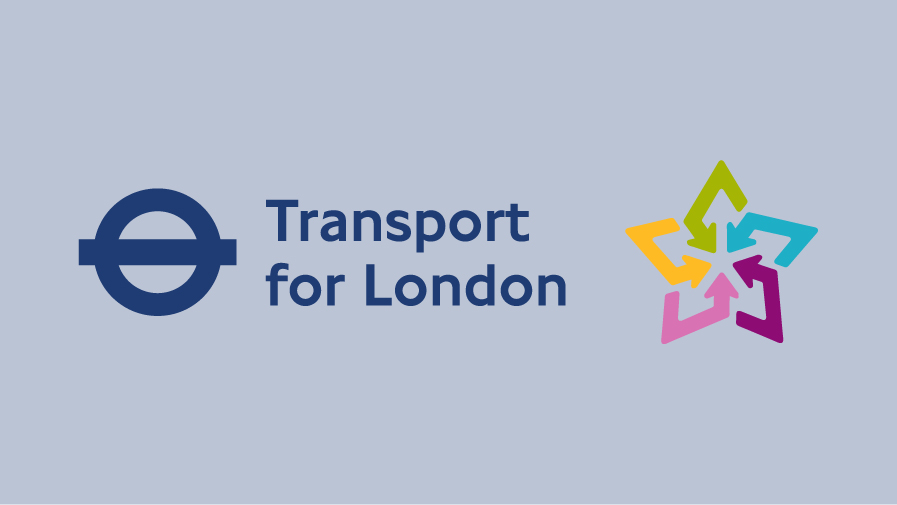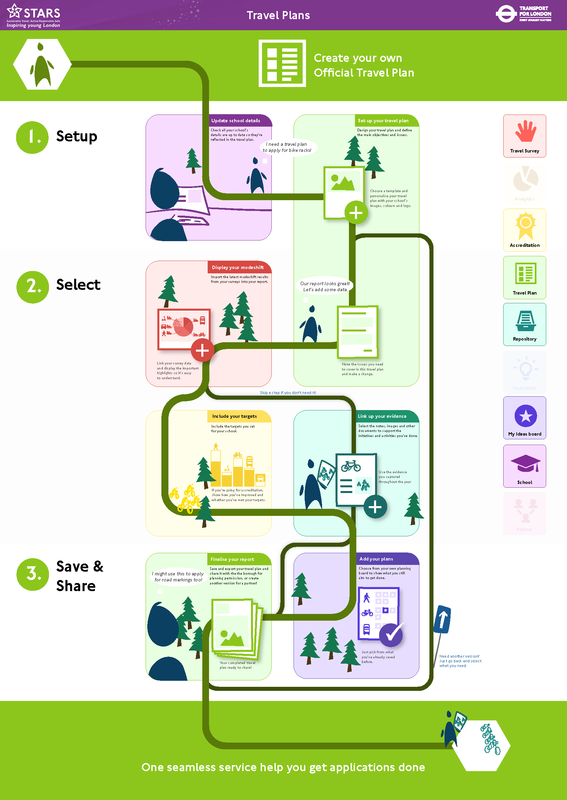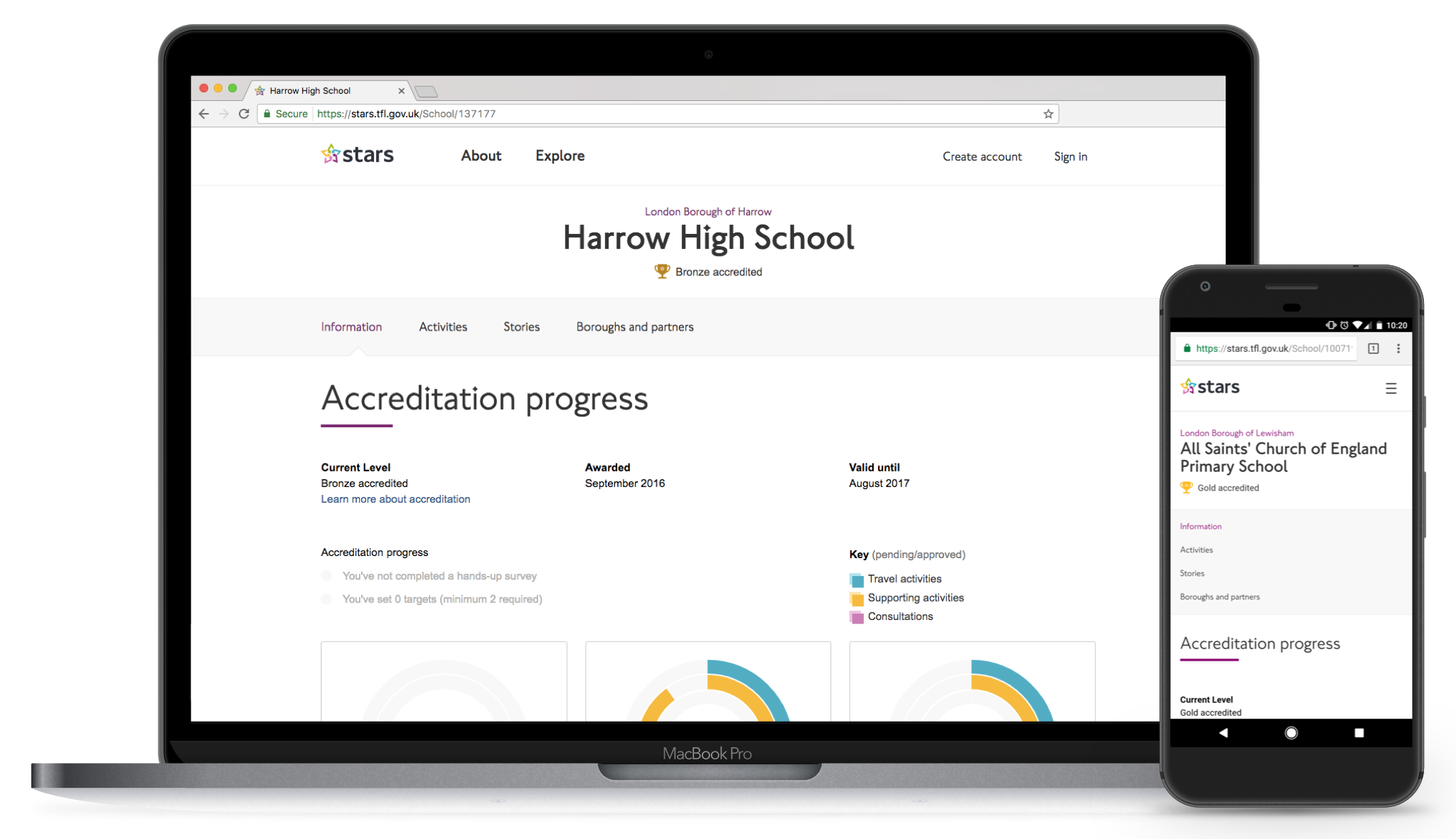
TfL STARS - Motivating school children to travel actively
End to end service and product redesign.
TfL STARS
Motivating school children to travel actively
The challenge
Redesign a broken Transport for London service and product so that London school children are motivated and empowered to travel to school in an active way.
The outcome
Societal change.
An experience so intuitive schools are letting children use it to plan and document activities, therefore freeing up teachers.
Restored faith and trust in the TfL STARS programme.
My role
Alongside a senior designer I was:
Interviewing
Observing
Visiting
Designing
Workshopping
Prototyping
Iterating
Presenting
Persuading

The STARS service my colleague and I redesigned and launched
“43% of traffic in London between 8.00am - 9.00am is caused by ‘educational trips’”
The context
STARS is a scheme run by Transport for London (TfL) that aims to encourage school children in London to travel to and from school actively.
Given 43% of traffic in London between 8.00am - 9.00am is caused by ‘educational trips’, getting an initiative like this working well is in TfL’s best interests and their ongoing mission to reduce congestion in the capital.
However, the current digital and service experience is very poor. It’s outdated, frustrating and taking up too much time from school teachers and Borough Officers, STARS’ main users.
“In it’s current state, STARS is simply unsustainable for TfL”
What’s the problem?
We spent a month discovering the current state of STARS and the true problems to be solved.
Meeting with schools and Borough Officers and uncovered a range of issues. From not being able to update and share content with other schools, to, the system being overly complex for school teachers to use.

Problems and problem areas uncovered during the discovery
Setting the vision
My involvement in the project started at this point.
My colleague had discovered a ton of insight and we were now in a position to begin to synthesise it, create meaning from it, and set a clear direction and vision for where we wanted to take STARS, one that our stakeholders needed to get behind.
“We needed to get our stakeholders behind the vision for where
we wanted to take STARS”
To do so we created three future journeys that encompassed the main STARS tasks that schools do during the academic year.
Future journeys
1. Initiatives & Activities
Schools will get inspired and find activities to do that will encourage modeshift. Simple documenting of evidence and comparing the activity the user did to how other schools did it.

2. Modeshift surveys
Individual classes complete their own modeshift surveys and upload the results. This takes the burden off the one teacher responsible for STARS.

3. Travel Plans
Ability to tailor what goes into a travel plan so it best reflects the school and what the school is applying for. A polished well formatted document is the output that schools can use to better support their applications with.

“The future journeys made the insight tangible, our stakeholders could see the direction, and they were all for it!”
Experience principles
We also created eight experience principles that would guide the future creation. The stakeholders were excited by these principles as they knew it was what schools wanted and if the product was designed following them, it would go down well.

A powerful metaphor
We also came up with a metaphor to describe a key part of the application - getting inspired, finding and planning activities to do.
We decided all activities would be on Activity Cards, the initial idea was sparked from recipe cards you get from Hello Fresh and Waitrose.

So we created Activity Cards. Use them as a guide to create the activity that works best for you and your school. The cards could also be printed and stuck around schools to encourage active travel further.
“The simple metaphor connected and stuck with people.”
Mobilisation phase
Equipped with all of the materials above we began a 5 week mobilisation phase.
The main objectives were to test our hypothesised journeys and prototype, gather further insight and prioritise what functionality should be built first.
Meeting schools
Over the course of the five weeks my colleague and I met with many schools, covering the different types of school that would use STARS:
- The type of school: nursery, SEN, primary, secondary
- STARS accreditation level: bronze, silver and gold
- Well performing and poorly performing STARS schools
Meeting Borough Officers
In parallel to meeting with schools we also met with Borough Officers. Borough Officers look after all of the schools in the London borough that they represent. We conducted two co-discovery and co-design workshops with Borough Officers representing different London boroughs.
Mobilisation outcome
By the end of the mobilisation phase we knew we had a product that was desirable from a schools and Borough Officer point of view.
The speed in which we were working allowed for quick iterations and a constant feeling that the product was progressing and getting closer to what schools needed.

Workshops with Borough Officers from different London boroughs
“After finishing one session with a school I was iterating the prototype on the tube on the way to the next session”
Build sprints
With the Mobilisation phase complete and the team assembled we began product development sprints.
I was part of a large multidisciplinary agile team working in 2 week sprints. As a team we were delivering a new part of the product quickly and often.

It was my first experience working in an agile development team and luckily it was a good one. We were under the supervision of an experienced Scrum Master who followed agile methodologies strictly.
Before each sprint we would all do sprint planning as a team together. Story pointing how much development effort would be needed using the Fibonacci Sequence.

Sprint board
Sprint style
My colleague and I ran one sprint ahead of development. This was to ensure development had enough to build. By being one sprint ahead we always had new functionality to handover.
Working in an agile and iterative fashion there was no documentation. We would check in with the back and front end development leads during our design sprint to ensure what we were proposing could be built and built in sufficient time.
The two week sprints for me were commonly split as shown below.

Typically how I spent my time during the two week sprints.
“Time with our users was split 50/50 between testing what we had designed in the current sprint, and discovering new insights to inform the next sprint.”

Visiting schools, testing ideas, iterating prototypes
Introducing STARS
TfL’s STARS accreditation scheme inspires young Londoners to think differently about travel and its impact on their health, wellbeing and the environment.

Get inspired
Schools can now find a range of activities to complete that will encourage active travel. They have the option of filtering by areas of focus should they wish to hone in on a particular type of activity.

Compare against schools
Schools can view how other schools are getting on and how they’ve got to their accreditation level.

See how others have done it
Schools can read how other others have adapted Activity Cards to suit their unique needs. The product is now much more inclusive, special needs schools feel a part of the community.

The impact
STARS launched in October 2016 ahead of the upcoming academic year.
"I really like the overall layout as it has a lot of information but makes it easy to absorb. The transition from page to page for information is easy to comprehend. Looking for schools is easy and I really appreciate schools details being automatically updated from Edubase. This is a lifesaver! Overall, very happy."
Carla, Westminster Borough officer
"I’m loving the new site. It is very user friendly. I’ve added loads already!! That’s the beauty of the new site! It’s really easy to adapt titles etc to make it relevant for individual schools. Also, it looks so lovely!"
Anika, Deputy Head of Wormholt Park Primary School
"The system looks better than I could have imagined – I am so glad that the direction was to be a resource centre rather than a tick box report generator. It looks fantastic, easy to use, logical and exciting."
Jay, Havering Borough officer
"We are really pleased with the refreshed site. The schools had a showcase at the regional STARS seminar and the feedback was excellent. The borough officers have had detailed run throughs last week and again the feedback has been great. The site can already do more for schools and is much easier, simpler, clearer and intuitive to use."
Clare, STARS Product Owner, TfL Schools and Young People Manager
"…I’m so excited about the launch of the new site!! It really is fantastic from what I’ve seen so far!"
Lewis, Croydon Borough Officer
"Thank you, this looks fab. This will really help to make STARS expand further."
Marina, TfL Schools and Young People